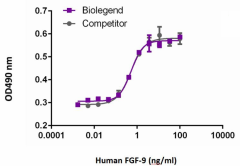- Regulatory Status
- RUO
- Other Names
- Fibroblast Growth Factor 9, Glia-Activating Factor (GAF), Heparin-Binding Growth Factor 9 (HBGF-9), HBFG-9, SYNS3

-

Human FGF‐9 induces NIH3T3 cell proliferation in a dose‐dependent manner. BioLegend’s human FGF‐9 product was compared side‐by‐side to a competitor’s equivalent product.
| Cat # | Size | Price | Quantity Check Availability | ||
|---|---|---|---|---|---|
| 558702 | 10 µg | $147.00 | |||
| 558704 | 25 µg | $253.00 | |||
Select size of product is eligible for a 40% discount! Promotion valid until December 31, 2024. Exclusions apply. To view full promotion terms and conditions or to contact your local BioLegend representative to receive a quote, visit our webpage.
FGF-9 is a member of the fibroblast growth factor family. It is a potent mitogen and can stimulate proliferation and invasion capacity of epithelial cells. FGF-9 also plays an important role in lung development and maintenance in the adult organ. FGF-9 is expressed in the lung mesothelium and epithelium. FGF-9 regulates lung branching by stimulating mesenchymal proliferation and inducing FGF-10 expression in the mesenchyme. FGF-9 deficient mice exhibit severely impaired lung development and die in the perinatal period. FGF-9 deficient mice also exhibit other phenotypes including testicular hypoplasia and male-to-female sex reversion. Additional studies have shown that FGF-9 is required for normal sex determination by maintaining SOX9 expression. FGF-9 also regulates testosterone production in the mouse Leydig cell through AKT and MAPK signaling pathways. FGF-9 can be detected in the central nervous system and promotes the differentiation and survival of both neurons and glia cells. FGF-9 also regulates gap-junction formation in cultured astroglial cells. FGF-9 is also involved in bone formation, retinal differentiation and maturation, wound healing, and maintaining the stemness of kidney nephron progenitors. Expression of FGF-9 can be transcriptionally induced by prostaglandin E2, estrogen, and hypoxia. It has been shown that FGF-9 can form dimers and the dimeric FGF-9 binds to heparin with a higher affinity than the monomeric FGF-9. Overexpression of FGF-9 has been associated with many human cancers such as ovarian endometrioid adenocarcinomas, glioma, prostate cancer, and endometriosis.
Product Details
- Source
- Human FGF-9, amino acids (Met1-Ser208) (Accession# NP_002001.1), was expressed in E. coli.
- Molecular Mass
- The 208 amino acid recombinant protein has a predicted molecular mass of approximately 23 kD. The DTT-reduced and non-reduced protein migrate at approximately 23 kD by SDS-PAGE. The predicted N-terminal amino acid is Met.
- Purity
- >95%, as determined by Coomassie stained SDS-PAGE.
- Formulation
- 0.22 µm filtered protein solution is in 20 mM Tris, pH 8.0, 10% glycerol, 100 mM NaCl, and 1% CHAPS.
- Endotoxin Level
- Less than 0.01 ng per µg cytokine as determined by the LAL method.
- Concentration
- 10 and 25 µg sizes are bottled at 200 µg/mL. 100 µg size and larger sizes are lot-specific and bottled at the concentration indicated on the vial. To obtain lot-specific concentration and expiration, please enter the lot number in our Certificate of Analysis online tool.
- Storage & Handling
- Unopened vial can be stored between 2°C and 8°C for up to 2 weeks, at -20°C for up to six months, or at -70°C or colder until the expiration date. For maximum results, quick spin vial prior to opening. The protein can be aliquoted and stored at -20°C or colder. Stock solutions can also be prepared at 50 - 100 µg/mL in appropriate sterile buffer, carrier protein such as 0.2 - 1% BSA or HSA can be added when preparing the stock solution. Aliquots can be stored between 2°C and 8°C for up to one week and stored at -20°C or colder for up to 3 months. Avoid repeated freeze/thaw cycles.
- Activity
- The ED50 is 0.2 - 1.0 ng/ml, corresponding to a specific activity of 1.0 - 5.0 x 106 units/mg, as determined by a dose-dependent stimulation of NIH3T3 cell proliferation without heparin added to the culture.
- Application
-
Bioassay
- Application Notes
-
BioLegend carrier-free recombinant proteins provided in liquid format are shipped on blue-ice. Our comparison testing data indicates that when handled and stored as recommended, the liquid format has equal or better stability and shelf-life compared to commercially available lyophilized proteins after reconstitution. Our liquid proteins are verified in-house to maintain activity after shipping on blue ice and are backed by our 100% satisfaction guarantee. If you have any concerns, contact us at tech@biolegend.com.
Antigen Details
- Structure
- Growth factor.
- Distribution
-
Expression of FGF-9 has been reported in lung, γδ T cells, central nervous systems, the epithelium of tooth germs, and the prostate epithelium.
- Function
- FGF-9 is involved in embryonic development and many biological functions at adulthood. FGF-9 is induced by PGE2.
- Interaction
- Leydig cells, intestinal mesenchymal stem cells, lung mesenchymal cells, cranial mesenchymal cells, glial cells, fibroblasts, and epithelial cells.
- Ligand/Receptor
- FGF-9 binds and activates the IIIc isoforms of FGFR1, FGFR2, and FGFR3 and the IIIb isoform of FGFR3.
- Cell Type
- Embryonic Stem Cells, Hematopoietic stem and progenitors, Mesenchymal Stem Cells, Neural Stem Cells
- Biology Area
- Cell Biology, Neuroscience, Stem Cells, Synaptic Biology
- Molecular Family
- Cytokines/Chemokines, Growth Factors
- Antigen References
-
1. Hendrix ND, et al. 2006. Cancer Res. 66:1354.
2. Colvin JS, et al. 2001. Cell 104:875.
3. Colvin JS, et al. 2001. Development 128:2095.
4. Zhang X, et al. 2006. J. Biol. Chem. 281:15694.
5. Gay D, et al. 2013. Nat. Med. 7:916.
6. Harada M, et al. 2009. Nat. Genet. 41:289.
7. Lai MS, et al. 2014. PLoS One 9:e90243.
8. Barak H, et al. 2012. Dev. Cell 22:1191.
9. Santos-Ocampo S, et al. 1996. J. Biol. Chem. 271:1726.
10. Geske M, et al. 2008. Development 135:2959. - Gene ID
- 2254 View all products for this Gene ID
- UniProt
- View information about FGF-9 on UniProt.org
